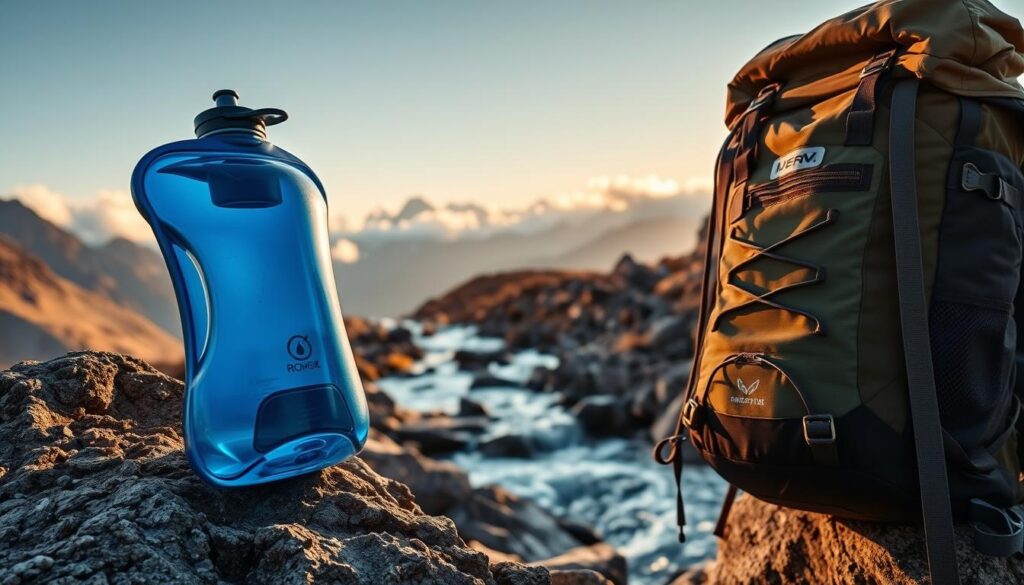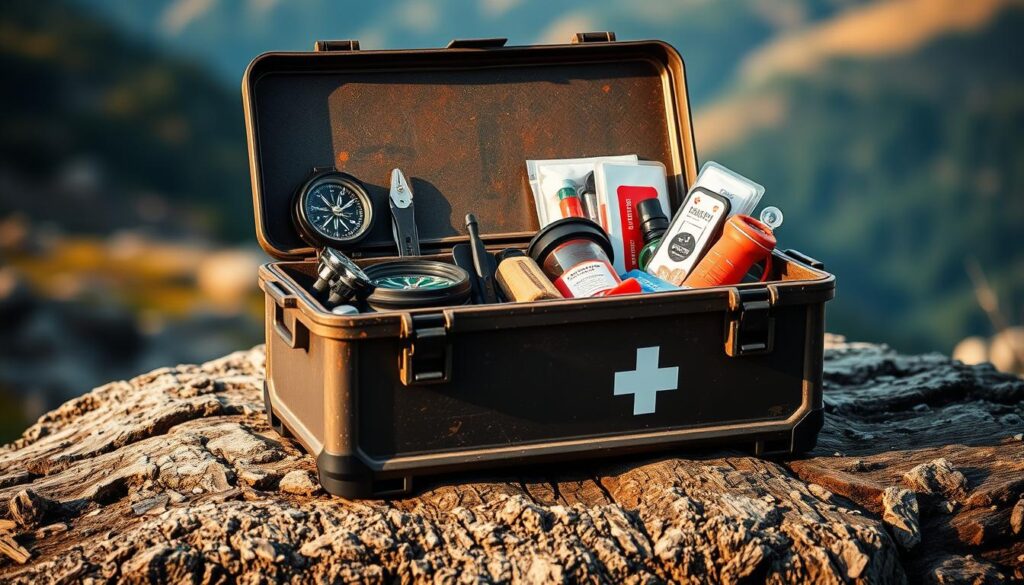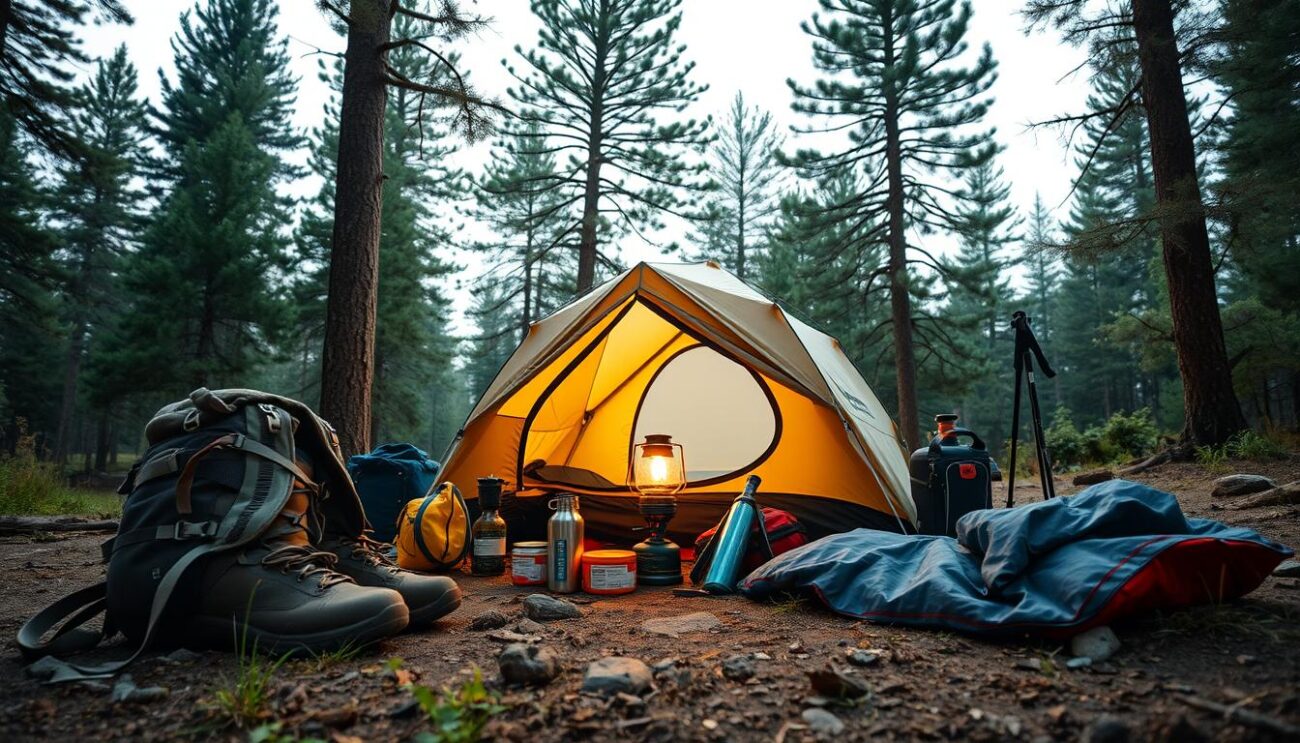Did you know over 40 million Americans go into the wilderness each year? Many more check out local parks and trails. When we head out for outdoor escapades, being ready is key for a safe and fun time.
We’ll show you the basics of outdoor preparedness. We’ll cover navigation and communication, shelter and sleep, hydration, and food. Whether you’re a pro hiker or just like to camp, the right survival tools and camping gear can really help.
When we go out into nature, having the right gear is crucial. In this article, we’ll give you a detailed guide. It will help you pick the best gear for your next adventure.
Key Takeaways
- Understand the essentials of outdoor preparedness.
- Learn about the must-have survival tools and camping gear.
- Discover how to choose the right gear for your next outdoor adventure.
- Explore the importance of navigation and communication systems.
- Find out how to manage hydration and nutrition effectively.
The Fundamentals of Outdoor Preparedness
Getting ready for the outdoors is more than just the right gear. It’s about knowing the environment and possible challenges. We need the right knowledge and tools to face obstacles and have a safe, fun time.
Assessing Environmental Challenges
It’s key to understand the environmental challenges we might face. This means looking at various factors that could affect our adventure.
Climate Considerations
The climate greatly affects the outdoor survival equipment we need. For cold weather, we need insulation. For hot weather, breathable fabrics are better. We should research the climate of our destination and pack the right gear.
Terrain Analysis
Understanding the terrain is also crucial. It helps us spot hazards like rough landscapes, water, or steep slopes. Knowing the terrain lets us choose the right emergency preparedness supplies and plan our route safely.
Duration-Based Equipment Planning
The length of our trip affects the wilderness survival tools we need. Longer trips mean more supplies, like food, water, and shelter. It’s important to be prepared but not carry too much.
Weight vs. Functionality Trade-offs
Choosing outdoor survival equipment means weighing lightness against functionality. While light gear is appealing, it must still meet our needs. We should pick items that do more and consider pack weight for a comfortable journey.
Navigation and Communication Systems
Exploring the outdoors requires reliable navigation and communication tools. Whether trekking through forests or climbing mountains, these tools are crucial. They can make the difference between a safe journey and a dangerous one.
GPS Devices and Traditional Compasses
GPS devices and compasses are key for navigation. GPS devices give accurate location info and are great in unknown places. Satellite navigation options have changed how we navigate, offering real-time data and tracking.
Satellite Navigation Options
Satellite systems like GPS and GLONASS give precise location info. They are essential for wilderness travel. These systems help track routes, find landmarks, and stay on track.
Map Reading Essentials
Even with GPS, map reading skills are vital. Knowing how to read topographic maps and use a compass is crucial. Always carry a detailed map and know how to use it with a compass.
Emergency Communication Tools
Emergency communication devices are also key. They help stay in touch with the world and call for help in emergencies. Satellite phones and messengers are popular among outdoor lovers.
Satellite Phones and Messengers
Satellite phones work where cell service doesn’t. Devices like Garmin inReach and DeLorme let users send messages and track journeys. They can also send an SOS alert in emergencies.
Personal Locator Beacons
Personal Locator Beacons (PLBs) send a distress signal in emergencies. They are great for solo travelers or those in remote areas with no cell service.
| Device | Function | Use Case |
|---|---|---|
| GPS Device | Navigation | Trekking, Hiking |
| Satellite Phone | Communication | Emergency Situations, Remote Areas |
| PLB | Distress Signal | Life-Threatening Emergencies |
Power Solutions for Electronic Devices
With more reliance on devices, power solutions are key. Portable power banks, solar chargers, and rechargeable batteries keep devices working. They are essential for any adventure.
Using the right navigation tools, communication devices, and power solutions makes outdoor adventures safer and more enjoyable.
Shelter and Sleep Systems for Wilderness Survival
When you go into the wilderness, having the right shelter and sleep systems is key. A good shelter keeps you safe from the weather. A good sleep system helps you rest well for the challenges ahead.
All-Weather Tent Options
Choosing a tent can be hard with so many options. Four-season tents are great for harsh weather like heavy snow and strong winds. They’re perfect for mountaineering and winter trips.
Four-Season vs. Three-Season Designs
Three-season tents are lighter and better for spring, summer, and fall. They have better air flow and are roomier. But, they can’t handle snow and wind like four-season tents.
Emergency Bivouacs
In survival situations, an emergency bivouac sack is crucial. These small sacks offer some protection against the weather. They work well with a sleeping bag to keep you warm.
Temperature-Rated Sleeping Equipment
A good night’s sleep starts with the right gear. Sleeping bags come in different temperature ratings. Pick one that matches the low temperature of your trip.
Down vs. Synthetic Insulation
Down insulation is warm but loses its warmth when wet. Synthetic insulation is heavier but keeps you warm even when damp. It’s better for wet conditions.
Sleeping Pad R-Values
The R-value of a sleeping pad shows how well it keeps you warm. Higher R-values mean better warmth. For cold weather, choose an R-value of 3 or higher.
Hammock Systems and Accessories
Hammock systems are a great choice if you don’t want to sleep on the ground. When picking a hammock, think about the suspension, bug nets, and rain tarps. They make your sleep comfortable and dry.
- Look for durable materials and weather-resistant designs.
- Consider the weight and packed size for your backpack.
- Accessories like bug nets and rain tarps can enhance your hammock experience.
Hydration Management and Water Treatment
Staying hydrated is key for a successful outdoor trip. It needs good planning and the right gear. Good hydration lets adventurers do their best, even in tough places.
Hydration Reservoirs and Bottles
Picking the right hydration gear is important. Hydration reservoirs like CamelBak make drinking water easy. Look for size, durability, and how easy it is to clean.
Bottles from Nalgene or Platypus are also great. They’re tough and easy to use. You can use them for hiking or survival.

Filtration Technologies
Clean drinking water is essential. Filtration technologies help keep water safe. There are many types, each with its own benefits.
Mechanical Filters
Mechanical filters, like Sawyer or LifeStraw, remove bad stuff from water. They work against bacteria, viruses, and dirt. They’re a solid choice for outdoor fans.
Chemical Purification
Chemical purification uses tablets or liquids to kill germs. It’s good against many pathogens. Chlorine dioxide tablets are easy to use and work well.
Natural Water Collection Techniques
Knowing how to find water naturally is also important. Skills like using condensation traps or finding water in plants can save lives.
Condensation Traps
Condensation traps get water from the air. They’re great in dry places.
Plant-Based Water Sources
Some plants, like desert willow or cacti, have water. Learning to safely get water from these plants is crucial.
By using good hydration gear and water treatment, outdoor lovers can have a safe and fun trip. Whether it’s advanced filters or natural methods, staying hydrated is possible.
Nutrition and Cooking Equipment
Proper nutrition planning and cooking equipment are key for outdoor adventures. Good nutrition keeps your energy up during activities. The right cooking gear lets you make meals safely and quickly.
Portable Stove Systems
A reliable stove system is crucial for outdoor cooking. There are many types of portable stoves, each with its own benefits.
Canister vs. Liquid Fuel
Canister stoves are simple and easy to use. They’re light and small, perfect for backpacking. Liquid fuel stoves are more versatile and work well in cold weather.
Wood-Burning Alternatives
Wood-burning stoves are a green choice. They use natural materials from the environment, cutting down on non-renewable resource use.
Food Planning and Preservation
Planning your meals is key for outdoor nutrition. You need to think about how many calories you’ll burn and choose foods that are nutritious and easy to make.
Caloric Requirements for Outdoor Activities
The calories you need vary based on your activity level. Aim for 2,000 to 4,000 calories a day, depending on how hard you’re working.
Dehydrated and Freeze-Dried Options
Dehydrated and freeze-dried meals are favorites among outdoor lovers. They’re light and last a long time. Just add hot water to rehydrate them.
Cookware and Utensil Selection
Picking the right cookware and utensils is important for outdoor cooking. Look for things that are light, strong, and can handle high heat.
- Choose a pot and pan set from materials like titanium or aluminum.
- Opt for utensils that are small and can do many things.
- Remember to pack a spork or multi-tool for extra usefulness.
By choosing the right cooking gear and planning your meals, you can have a safe and fun outdoor adventure.
Essential Outdoor Adventure Gear and Survival Tools for Any Expedition
When you head into the wilderness, the right survival gear is key. It ensures a safe and successful trip. As outdoor lovers, we must be ready for anything.
Multi-functional Tools and Knives
A good multi-functional tool or knife is vital for any survival gear box. These tools can do many tasks. They help with cutting, chopping, opening cans, and tightening loose parts.
Fixed Blade vs. Folding Designs
Knives come in two main types: fixed blade and folding. Fixed blade knives are strong and durable, perfect for tough tasks. Folding knives are portable and easy to carry, great for backpackers and hikers.
Tool Material Considerations
The material of a multi-functional tool or knife matters. High-carbon stainless steel is popular. It’s strong, resistant to corrosion, and keeps a sharp edge well.
Fire Creation and Maintenance
Fire is essential for outdoor adventures. It provides warmth, light, and a way to cook food. You’ll need the right tools and skills to create and keep a fire.
All-Weather Fire Starters
An all-weather fire starter is crucial for outdoor fans. These tools start fires in tough conditions, like rain or snow.
Tinder Preparation
You also need to prepare your tinder. This means gathering dry, fluffy material that lights easily. Dry leaves or grass work well.
Tactical Illumination Options
Tactical illumination is key for outdoor gear. A good headlamp or flashlight gives light after dark. It helps you navigate and do tasks.
Headlamps and Flashlights
For tactical illumination, choose between headlamps and flashlights. Headlamps are great for hands-free use. Flashlights are often more powerful and can signal for help.
Battery Types and Runtime
The battery type in your headlamp or flashlight matters. Rechargeable batteries are a smart choice. They save money and reduce waste over time.
| Tool | Key Features | Best Use |
|---|---|---|
| Multi-functional Tool | Variety of functions, durable construction | General outdoor tasks |
| Fixed Blade Knife | Strong, durable, sharp edge | Heavy-duty tasks, self-defense |
| Headlamp | Hands-free use, adjustable brightness | Navigation, tasks after dark |

Adding these essential tools and gear to your survival gear box prepares you for any outdoor adventure. Always check your gear before you go. Practice using it to feel confident and ready.
Weather Protection and Technical Clothing
The right clothes and gear can make a big difference outside. Knowing about weather protection and technical clothing is key.
The Science of Layering
Layering is important in outdoor clothes. It lets you change what you wear as the weather changes. You usually have a base layer, insulating layer, and outer shell.
Base Layer Materials
Base layers pull moisture away from your skin. They’re made from merino wool or synthetic fabrics like polyester. This keeps you warm and stops you from getting cold.
Insulation Technologies
Insulating layers keep you warm by trapping air. Down insulation and synthetic insulations (like Polarguard) offer different levels of warmth and work in wet weather.
Footwear Selection by Activity
Choosing the right shoes is key for comfort and performance outside. Different activities need different shoes.
Boot Construction Features
When picking boots, look at waterproofing membranes (like Gore-Tex), breathability, and ankle support. These features make boots perform better and last longer.
Sock Systems and Blister Prevention
A good sock system can stop blisters and discomfort. Choose socks that wick moisture away and consider wearing layers for extra comfort.
Waterproof Gear and Moisture Management
Waterproof gear keeps you dry in wet weather. Look for jackets and pants with waterproof and breathable membranes. Also, managing moisture with ventilation and breathable fabrics makes high-intensity activities more comfortable.
Building Your Comprehensive Survival Gear Box
A good survival gear box is key for outdoor adventures. It’s important to be ready for emergencies in the wild. We’ll show you what to include in your box to stay safe.
Medical and First Aid Components
Medical and first aid items are crucial. They help treat injuries and stop infections.
Wound Care Essentials
- Bandages and Band-Aids for covering cuts and scrapes.
- Antiseptic Wipes for cleaning wounds.
- Gauze Pads for applying pressure to stop bleeding.
Medication Considerations
Don’t forget personal medications and a basic first aid kit. Include pain relievers and antihistamines.
Emergency Signaling Equipment
Being able to signal for help is vital in emergencies. Your box should have visual and audible devices.
Visual Signals
- Signal Mirrors for reflecting sunlight towards potential rescuers.
- Flares for creating a visible signal during the day or night.
Audible Alerts
- Whistles for signaling your location.
- Sirens or other loud noise-making devices for attracting attention.
Documentation and Information Resources
Right documentation and info can be lifesaving in survival situations.
Field Guides and Reference Materials
A field guide is essential. It helps with edible plants, navigation, and weather.
Emergency Contact Protocols
Keep a list of emergency contacts and a plan for using your devices to call for help.
With these items in your survival gear box, you’ll be ready for emergencies. This ensures a safer outdoor adventure.
When it comes to outdoor adventures, being prepared is key to staying safe and enjoying the experience. BattlBox offers a unique solution for adventurers, survivalists, and those who simply want to be ready for the unexpected. Their curated survival gear boxes are packed with top-quality, essential tools designed for a wide range of outdoor situations.
From tactical knives and first aid kits to emergency blankets and fire-starting kits, BattlBox ensures that you have everything you need to tackle the wilderness with confidence. Each box is thoughtfully designed by experts, giving you the peace of mind that comes with knowing you’re ready for anything nature throws your way.
Whether you’re hiking, camping, or prepping for the unexpected, BattlBox has your back. With different subscription options to suit various needs, you can ensure that you’re always equipped with the best survival tools available.
